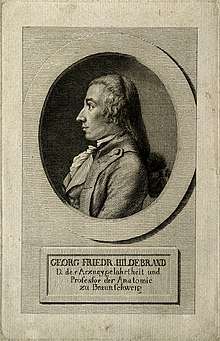Georg Friedrich Hildebrandt
Georg Friedrich Hildebrandt (5 June 1764 – 23 March 1816) was a pharmacist, chemist, and anatomist. He was an early supporter of Lavoisier's theories in Germany. He investigated mercury compounds, and the chemical nature of quicklime, ammonium nitrate, and ammonia. He studied light emitted by electric discharges through air and investigated the use of nitric oxide to determine the oxygen content of air. He developed a method to separate silver from copper. He wrote textbooks on pharmacology and human anatomy, and treatises on smallpox, sleep, and the digestive system.
Georg Friedrich Hildebrandt | |
|---|---|
 Portrait. Credit: Wellcome Collection | |
| Born | 5 June 1764 |
| Died | 23 March 1816 (aged 51) |
| Nationality | German |
| Alma mater | University of Göttingen |
| Scientific career | |
| Fields | Pharmacist, chemist, and anatomist |
| Institutions | University of Erlangen |
| Doctoral advisor | Johann Friedrich Gmelin |
| Doctoral students | Johann Salomo Christoph Schweigger |
He obtained his MD in 1783 from the University of Göttingen under Johann Friedrich Gmelin.
Works
- Anfangsgründe der Chemie . Vol. 3 . Erlangen : Walther, 1794 Digital edition by the University and State Library Düsseldorf
gollark: That sounds outdoors and thus impossible.
gollark: If we're going for mercury why not FOOF?
gollark: Yes they are. They actually exceed the Landauer limit by adjusting local bee fields.
gollark: This is why my room is leaky and incredibly poorly heated, of course.
gollark: Humans work worse, interestingly. There's detectable cognitive function loss with higher CO2.
References
- K. Hufbauer, The Formation of the German Chemical Community (1720–1795), University of California Press, 1982, p. 214.
- Dictionary of Scientific Biography, Charles Scribner's Sons, 1970–1990, vol. 6, p. 395.
- J. fur Chemie und Physik, 1819, 25, pp. 1–16.
- J. R. Partington, A History of Chemistry, Macmillan, 1962, vol. 3, pp. 638–639.
This article is issued from Wikipedia. The text is licensed under Creative Commons - Attribution - Sharealike. Additional terms may apply for the media files.